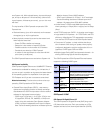The requirements for channel extension equipment are
simplifi ed with the increased number of commands in
fl ight. This may benefi t z/OS Global Mirror (Extended
Remote Copy – XRC) applications as the channel exten-
sion kit is no longer required to simulate specifi c channel
commands. Simplifying the channel extension require-
ments may help reduce the total cost of ownership of end-
to-end solutions.
Extended distance FICON is transparent to operating sys-
tems and applies to all the FICON Express2 and FICON
Express4 features carrying native FICON traffi c (CHPID
type FC). For exploitation, the control unit must support the
new IU pacing protocol. The channel will default to cur-
rent pacing values when operating with control units that
cannot exploit extended distance FICON.
Exploitation of extended distance FICON is supported by
IBM System Storage DS8000 series Licensed Machine Code
(LMC) level 5.3.1xx.xx (bundle version 63.1.xx.xx), or later.
To support extended distance without performance deg-
radation, the buffer credits in the FICON director must be
set appropriately. The number of buffer credits required is
dependent upon the link data rate (1 Gbps, 2 Gbps, or 4
Gbps), the maximum number of buffer credits supported
by the FICON director or control unit, as well as application
and workload characteristics. High bandwidth at extended
distances is achievable only if enough buffer credits exist
to support the link data rate.
FICON Express enhancements for Storage Area Networks
N_Port ID Virtualization
N_Port ID Virtualization is designed to allow for sharing of
a single physical FCP channel among multiple operating
system images. Virtualization function is currently available
for ESCON and FICON channels, and is now available for
FCP channels. This function offers improved FCP channel
utilization due to fewer hardware requirements, and can
reduce the complexity of physical FCP I/O connectivity.
Program Directed re-IPL
Program Directed re-IPL is designed to enable an operat-
ing system to determine how and from where it had been
loaded. Further, Program Directed re-IPL may then request
that it be reloaded again from the same load device using
the same load parameters. In this way, Program Directed
re-IPL allows a program running natively in a partition to
trigger a re-IPL. This re-IPL is supported for both SCSI
and ECKD
™
devices. z/VM 5.3 provides support for guest
exploitation.
FICON Link Incident Reporting
FICON Link Incident Reporting is designed to allow an
operating system image (without operating intervention) to
register for link incident reports, which can improve the
ability to capture data for link error analysis. The informa-
tion can be displayed and is saved in the system log.
Serviceability Enhancements
Requests Node Identifi cation Data (RNID) is designed to
facilitate the resolution of fi ber optic cabling problems. You
can now request RNID data for a device attached to a
native FICON channel.
Local Area Network (LAN) connectivity –
OSA-Express3 – the newest family of LAN adapters
The third generation of Open Systems Adapter-Express
(OSA-Express3) features have been introduced to help
reduce latency and overhead, deliver double the port den-
sity of OSA-Express2, and provide increased throughput.
24


















